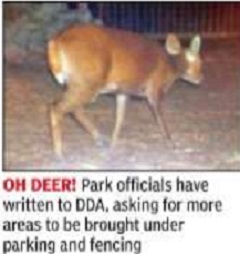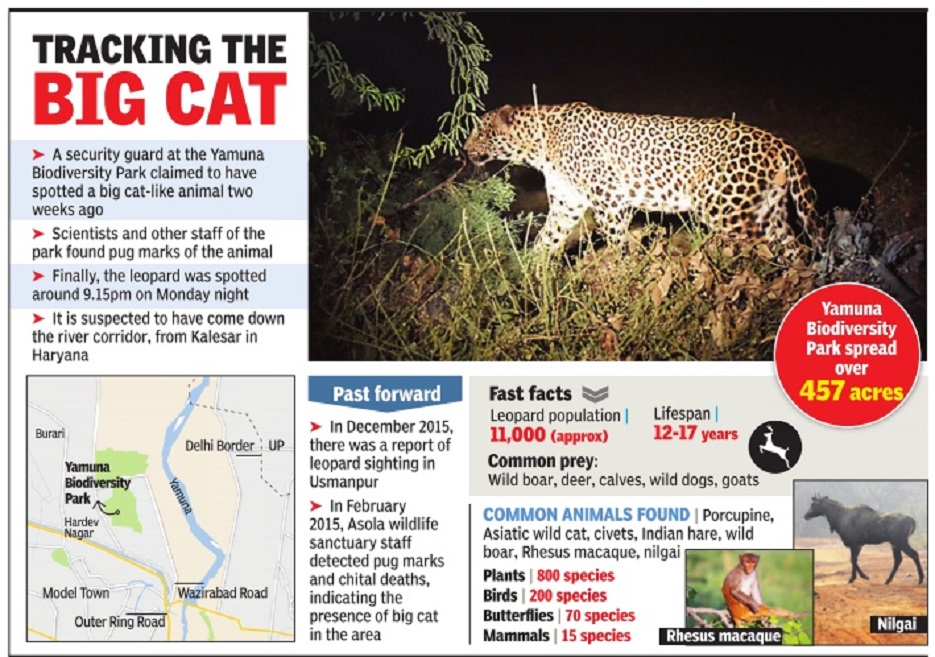Delhi: Yamuna Biodiversity Park
This is a collection of articles archived for the excellence of their content. |
Contents |
The animals
Barking deer
Sighted in 2016
Jasjeev Gandhiok. After leopard, barking deer caught on cam Dec 20 2016 : The Times of India
If the spotting of a leopard inside the Yamuna Biodiversity Park (YBP) was a sign of a healthy ecosystem, scientists at the park have now captured a barking deer on camera further proof that the habitat inside is becoming favourable to more species, experts said.
“It is a great sign for the ecosystem of the park. After finding a top carnivore, we now have a top herbivore. The presence of such species is essential for a balanced ecosystem,“ said C R Babu, professor emeritus, Delhi University and head of the Centre for Environmental Management of Degraded Ecosystems (CEMDE).
The barking deer or muntjac falls under schedule III of the Wildlife Protection Act, 1972 and is generally found in moist-deciduous forests. Experts said that it is very rarely sighted in Delhi.
Leopard
Pugmarks: 2015, sighting: 2016
Jasjeev Gandhiok, Leopard takes up residence in Delhi biopark, Nov 23 2016 : The Times of India
Jasjeev Gandhiok, Leopard takes up residence in Delhi biopark, Nov 23 2016 : The Times of India
Delhi may be an urban jungle but, amazingly , it still has space for wild predators. A leopard was caught on camera in the capital for the first time in Nov 2016, at night, that too far away from the place where another spotted cat's pugmarks were seen in 2015.
The leopard was clicked at the Yamuna Biodiversity Park (YBP) in north Delhi and officials say it may have become a `resident' as its pugmarks have been regularly seen for two weeks. The animal was finally captured on camera by scientists and support staff when it was spotted while they were The `Delhi leopard' is a male installing more surveillance devices. “This is a good sign and we suspect it may have become a resident animal with the habitat here more conducive. From early sightings, it appears to be a male leopard,“ said Faiyaz Khudsar, scientist incharge at YBP . Khudsar said officials had placed loose mud traps all over the biodiversity park to find the animal and even made a cast of the pugmark. “The marks confirmed it was a leopard, as did the stride measurement.On Monday night, when we were trying to install more traps, we spotted the animal and it stayed there for close to an hour,“ Khudsar said.
Leopard pugmarks were found last year at Asola Wildlife Sanctuary and a spotting was even reported in Usmanpur at the end of December 2015. To capture leopard and hyena sightings, several camera traps were also set up in Bandhwari and Mangar areas near Gurgaon.
Experts say the number of sightings of the leopard at YBP may mean it has decided to stay here for the time being.
“Yamuna Biodiversity Park now has all four trophic levels with the addition of a top carnivore like the leopard. This shows that through DDA's assistance, the ecosystem here is now is fully func tional and it appears that the animal has become a resident due to the suitable habitat available to it. We suspect a female leopard may also join soon,“ said C R Babu, professor emeritus, Delhi University and head of the Centre for Environmental Management of Degraded Ecosystems.
Experts at the park suspect it may have walked down the river plain from Kalesar in Haryana. “Leopards are known to travel as far as 700km. The nearest forest patch from here is Kalesar and it is possible it may have come down the river corridor from there,“ said Babu.
Leopards are known to feed on wild boar, pigs, dogs, goats and hare, among other species. Currently the animal is in phase-II of the biodiversity park which is spread across 200 sq metres. While villagers near the DDA-run biodiversity park have expressed fear, experts say there is no need to worry at the moment.
“Leopards have always lived close to people because they are a very adaptable species. Since they are such masters of camouflage, it is easy for them to use even thickets to remain unseen by people.However, it is important that large scale awareness activities are initiated and interdepartment coordination is carried out so that any untoward incidence is avoided,“ said Vidya Athreya, wildlife biologist specialising in leopards and in-charge of the Waghoba project in Maharashtra. Officials at the park also say security has been increased, but the chances of the leopard straying out are bleak.
“Around 90% of the time, leopards will try to avoid human activity and therefore it is difficult to spot them.It is plausible that it may decide to reside there if it gets sufficient water during the day and small animals to prey on. People should not panic,“ said Bilal Habib, wildlife biologist, Wildlife Institute of India.
Red-crested pochards
Yamuna Biodiversity Park welcomes winged guests
The Times of India, December 07 2014
Scientists are tracking the species and numbers of birds coming every year at the park to see how a managed wetland can support rich migratory bird fauna.
YBP is the only park which gets the red-crested pochards in the city according to field researchers at the park. Redcrested pochards come from central Asia, Spain and some south Asian countries. The other major attraction at the park are great cormorants, found in North America, Europe, Africa, China, India, southeast Asia, New Zealand, Papua New Guinea and Australia. “Summer breeding occurs in patches through much of central Asia up to eastern China, year-round wintering occurs in India and southern China, and birds can be found wintering in southeast Asia,“ according to Birdlife.org. Other birds that can be seen now are shovelers, pintails, gadwalls and darters.
“We mostly get birds from central Asia, Siberia and Europe. I have heard that this year arrival of migratory birds in other parts of northern India has been slow but at the YBP we have seen a stable trend for the last few years,“ said Faiyaz A Khudsar, scientist in-charge at Yamuna Biodiversity Park.
Snakes: Enhydris seiboldii

The Times of India, Jul 18 2015
Jayashree Nandi
GREEN REVIVAL - Snakes last seen in 1940s found at Yamuna bio park
Creepy-crawlies best avoided by most have been enchanting a team of scientists at Yamuna Biodiversity Park. They recently came across an adult Enhydris seiboldii, a smooth-scaled, mildly venomous water snake with an intricately-patterned skin in the company of its two newborns in a swamp inside the park.
Commonly known as Seibold's water snake, it may have been last seen in the capital in the 1940s, the team has subsequently found. Members are jubilant as it's an indicator that important swamp reptile species can be revived--with some effort.
Not much is known about this species of snake. It's not a very rare one for other river or swamp habitats. But in Delhi it is really rare. The snake was last mentioned as part of fauna in British India in 1943 by Smith. The same reference appears in a publication by Zoological Survey of India in 1996.
“They may not have had the habitat to breed. They don't lay eggs but give birth, being viviparous,“ says Faiyaz A Khudsar, scientist in charge at the park. Khudsar has released the adult and one newborn--the other is being studied and will be released in the wild soon.
A lot of common snakes are also seen very often at YBP--the wolf snake, cobra, blind snake, Indian krait, rat snakes and checkered keel back being a few. Khudsar has been looking out for snakes on the polluted Wazirabad-to-Okhla stretch along Yamuna but couldn't find any important species.
“Several things may have caused Enhydris seiboldii to disappear from Delhi. Factors include destruction of habitat, pollution in Yamuna and changes in the river system. I would say it's not a rare snake but spotting it in Delhi is im portant. It's good to know we have something important in the backyard,“ said `frogman of India' S D Biju who is also a Delhi University professor.
The rear-fanged Enhydris seiboldii has been renamed to Ferania seiboldii, feeds on fish and frogs and thrives around Eichhornia roots. “This snake is monogeneric--it belongs to one known genus. They like eating fresh water eels. Now we have an extended summer which may have affected their numbers,“ adds Debanik Mukherjee, a reptile expert.
“This snake cannot survive in polluted water. The eel, for instance, is not found widely in the Delhi stretch of Yamuna. But if the water is clean, they may come back,“ Khudsar says.
Revival/ 2017
See graphic

See also
Asola Bhatti Wildlife Sanctuary (Delhi/ Haryana)
Delhi: Yamuna Biodiversity Park



